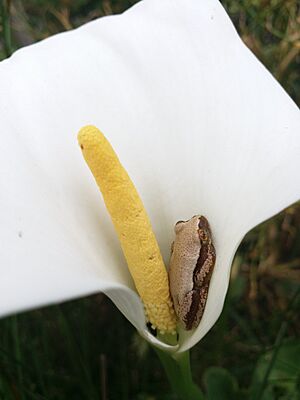Knysna banana frog facts for kids
Quick facts for kids Knysna banana frog |
|
|---|---|
| Conservation status | |
| Scientific classification |
The Knysna banana frog (Afrixalus knysnae) is a special kind of frog. It belongs to the family Hyperoliidae. This frog is only found in South Africa, which means it is endemic to that country.
Contents
Where Knysna Banana Frogs Live
These frogs live in different places, mostly near the coast of South Africa. Their natural habitats include cool forests and areas with Mediterranean-type plants. They also like freshwater marshes and ponds. Sometimes, they can even be found in farm fields or water storage areas.
The Knysna banana frog lives in a mix of different plant types along the coast. This includes mountain heathland and forests. These frogs like to breed in small dams and shallow water. The water needs to have lots of plants growing in it. They can even breed in well-planted garden ponds. Scientists think these frogs need very clean water to have their babies.
Sadly, the places where these frogs live are shrinking. This is because of things like new buildings, plants that don't belong there, and chemical pollution.
What Knysna Banana Frogs Look Like
The Knysna banana frog has a creamy yellow color. It also has brown stripes along its sides. If you touch a female frog, her skin feels smoother than a male's.
Knysna Banana Frog Population
Scientists are not sure exactly how the number of these frogs is changing. Their population has been going down quickly. It is hard to know if this is only because of new buildings, invasive plants, or pollution. It could also be a mix of all these problems.
The groups of these frogs are very spread out. No single place has more than half of all the frogs. The distances between these groups are too far for frogs to travel in one lifetime. This means they cannot easily find new mates. For example, scientists visited a place called Covie. They did not find any adult frogs or tadpoles there for three years. It seems this group might have disappeared. However, more visits are needed to be sure.
The main danger to these frogs is losing their homes. This happens because of new buildings and places for fun. It also happens because of afforestation (planting too many trees in one area), invasive vegetation (plants that take over), and agricultural expansion (more farms). Chemical pollution also harms them. These problems mostly affect the places where the frogs breed. Dry periods, called droughts, can also make life harder for these frogs.
What Knysna Banana Frogs Eat
The Knysna banana frog mainly eats insects.
Reproduction and Life Cycle
Female Knysna banana frogs lay between 20 and 50 eggs. They place these eggs on plants that are above the water. When the tadpoles hatch, they drop into the water. They stay there until they change into frogs.
Helping the Knysna Banana Frog
There are still many things scientists need to learn about these frogs. But it is very important to look at how changes in water quality affect them. If there is less urban development, fewer invasive plants, and less chemical pollution, it will help the frog population. However, it might not be enough to completely stop their numbers from going down.
Sources
- Bergmann, Travis; Zimkus, Breda; Gale Rosen, Daniel. 2012. Afrixalus knysnae. African Amphibians Lifedesk



